Notebook - January 26, 2000
Enrollment increase on table for
Board of Trustees
Report to recommend changes that will affect Princeton's future
Welcome to the new millennium: On January 29, 2000, after two years of
research and planning, a subcommittee of the Board of Trustees will present
the full board with its official recommendations on the future direction
of the university. The Wythes Report, named after the subcommittee's chairman,
Paul Wythes '55, intends to make suggestions in a number of areas, including
a recommendation that Princeton increase its undergraduate enrollment by
500 students (about 10 percent) over the next eight to 10 years. Other topics
to be covered include the Graduate School, the faculty, the administrative
and support staffs, the university's physical plant and financial resources,
the use of new technologies, and the Library.
The possibility of an enrollment expansion-which would call for the construction
of an additional dorm, as well as a sixth residential college-has already
been widely reported in The Daily Princetonian and cyberspace (the Prince
has given the idea the tentative thumbs up, while TigerNet's Internet chatter
is generally more dubious). With the publication of the Wythes Report, however,
debate is expected to begin in earnest.
According to university officials, the time is ripe for Princeton to
share its resources with more students: the university is financially in
great shape-it has the highest endowment per student in the nation-the size
of the faculty has been growing steadily in recent years, and the pool of
qualified applicants continues to grow.
"Our final vote on the plan probably won't happen until sometime
in April," said Wythes. "In the meantime, we intend to seek out
as much input as possible from the alumni and other groups."
PAW's March 8 issue will provide details of the Wythes Report, along
with an analysis of the reasons behind the suggested increase in the size
of Princeton's undergraduate student body-and what its impact on the university
will be.
--Royce Flippin '80
Wythes Report Topics
· Enrollment increase
· Graduate School
· Faculty
· Staff
· Physical plant
· Financial resources
· New technologies
· Library
Psychologist finds cells regenerate
in advanced area of brain
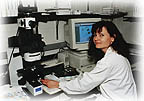 On October 15, Princeton psychologist Elizabeth Gould and her collaborators,
including Professor of Psychology Charles G. Gross, reported that in primates
the most advanced area of the adult brain receives fresh supplies of neurons
daily. The neuron is the basic unit in the brain's operating system, and
the discovery was a milestone in neuroscience. It delivered a final blow
to the longstanding belief that the adult brain can only lose neurons, never
add them. That dogma had begun to crumble in recent years, partly because
of earlier work by Gould showing that neurogenesis, the birth of neurons,takes
place in a more primitive part of the brain.
On October 15, Princeton psychologist Elizabeth Gould and her collaborators,
including Professor of Psychology Charles G. Gross, reported that in primates
the most advanced area of the adult brain receives fresh supplies of neurons
daily. The neuron is the basic unit in the brain's operating system, and
the discovery was a milestone in neuroscience. It delivered a final blow
to the longstanding belief that the adult brain can only lose neurons, never
add them. That dogma had begun to crumble in recent years, partly because
of earlier work by Gould showing that neurogenesis, the birth of neurons,takes
place in a more primitive part of the brain.
In their new work, published in Science, the Princeton scientists showed
that neurogenesis also occurs in the neocortex, which is the highest-functioning
area of the brain, responsible for memory, perception, and reasoning. Gould
spoke with PAW about her work.
What is the most exciting implication of your finding in terms of
understanding how the brain works?
Just in the simplest sense, having a new population of neurons at any
given time presents a totally different mechanism for learning. Learning
has almost always been thought of as a modification of existing neural circuits.
We know that the amount of information that can be learned over a long period
of time is enormous, and yet the brain was always believed to be structurally
static. Now we know that is not true-the brain is always undergoing structural
changes. This presents the possibility that it is new neurons being added
and new connections being formed that are important for learning.
In the long term, could your findings translate into new therapies
for brain disorders and injuries?
It's intuitive that tapping into a natural regenerative mechanism and
enhancing it in some way is a good approach for trying to repair damaged
brain regions. But we need to be careful not to overinterpret these basic
findings. It is well known that the adult brain is not very efficient at
repairing itself, and it is likely that the number of new cells added to
the neocortex would not be sufficient to repopulate a damaged area. For
our results to have clinical relevance, many new experiments will be necessary
to identify ways to enhance and direct this new neuron growth.
Anniversary Campaign hits $900
million
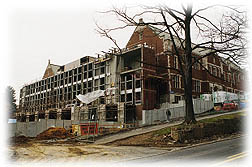 The Anniversary Campaign reached its revised goal of $900 million in
early November, eight months ahead of schedule. But Vice-President for Development
Van Zandt Williams, Jr. '65 cautions that the work is far from over. Some
categories of the campaign, such as academic programs, have been more successful
than others, leaving four areas in particular underfunded: Annual Giving,
financial aid, the Presidential Teaching Initiatives, and new buildings.
The Anniversary Campaign reached its revised goal of $900 million in
early November, eight months ahead of schedule. But Vice-President for Development
Van Zandt Williams, Jr. '65 cautions that the work is far from over. Some
categories of the campaign, such as academic programs, have been more successful
than others, leaving four areas in particular underfunded: Annual Giving,
financial aid, the Presidential Teaching Initiatives, and new buildings.
To fill those gaps the university hopes to raise at least $170 million
more by June 30, said Williams. The most important unmet goal is this year's
Annual Giving campaign, which has raised $9 million toward its goal of $35
million-typical progress for this time of year. Princeton's effort to improve
its financial- aid package for undergraduates and to strengthen the endowment
for graduate fellowships still requires more than $30 million. About $20
million is needed to fully fund the Presidential Teaching Initiatives, including
the new McGraw Center for Teaching and Learning and distinguished visiting
professorships. And to complete the funding for several buildings, including
the Frist Campus Center, the Princeton Stadium, the Wallace Social Sciences
Building, and dorm renovations, Princeton needs more than $100 million.
Medieval art goes online
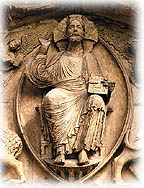 When Colum P. Hourihane arrived from London's Courtauld Institute to
take charge of Princeton's Index of Christian Art in 1997, staff members
worked on just one computer-what the Irish-born Hourihane calls "a
data-entry machine." Barely 1 percent of the Index's 250,000 text entries,
which describe the works of art, were on the Internet, and none of the 150,000
photographs had been digitized. Today 18,000 text entries are online and
15,000 photographs have been digitized.
When Colum P. Hourihane arrived from London's Courtauld Institute to
take charge of Princeton's Index of Christian Art in 1997, staff members
worked on just one computer-what the Irish-born Hourihane calls "a
data-entry machine." Barely 1 percent of the Index's 250,000 text entries,
which describe the works of art, were on the Internet, and none of the 150,000
photographs had been digitized. Today 18,000 text entries are online and
15,000 photographs have been digitized.
The most important and the largest archive of medieval art anywhere in
the world, the Index classifies and stores information on religious art
before the 14th century. Each entry-whether on a file card or on the Web-indicates
where the actual artwork is located, its medium, the date, and the artist.
The Index began in 1917 with file cards and black-and-white photographs
that art history professor Charles Rufus Morey collected in a shoe box.
File cards and photographs still make up a sizable part of the collection,
which is housed in the lower level of McCormick Hall.
About 1,000 works of art become available annually and are added electronically.
Recent new arrivals include images of all the sculptures from Chartres
and Amiens cathedrals and the mosaics of San Marco in Venice.
Outside money has made it possible to expand more rapidly onto the Web.
The Getty Grant Program is financing the Index's computerization of the
Pierpont Morgan Library's entire collection of 500 medieval manuscripts.
"This will add 32,000 images to our database," said Hourihane.
Subscribers from around the world can tap into the database and search
among 26,000 subjects, ranging from Christ and Jeremiah to bread, fools,
and palms, to locate text and images that they need.
-Ann Waldron
The Index of Christian Art's Website is www.princeton.edu/~ica/indexca.html.
Smith, Treiman
In Memoriam
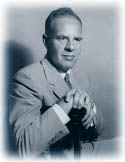 Datus C. Smith, Jr. '29, a book publisher and a former editor of the
Princeton Alumni Weekly died November 17. He was 92. After editing PAW from
1931 to 1939, he was the director of the Princeton University Press until
1952. Smith then served as president of Franklin Book Programs, a nonprofit
organization promoting the development of book publishing in the Third World.
Datus C. Smith, Jr. '29, a book publisher and a former editor of the
Princeton Alumni Weekly died November 17. He was 92. After editing PAW from
1931 to 1939, he was the director of the Princeton University Press until
1952. Smith then served as president of Franklin Book Programs, a nonprofit
organization promoting the development of book publishing in the Third World.
In 1967, he became a senior associate for John D. Rockefeller III '29,
serving as vice-president of the JDR III Fund, a foundation promoting the
arts and Asian-American cultural relations. He retired in 1973.
Eugene Higgins Professor of Physics, emeritus, Sam Bard Treiman, who
was at the center of Princeton physics for many years, died November 30
of leukemia in New York. He was 74. Born in Chicago, he served in the U.S.
Navy from 1944 to 1946, before earning his Ph.D. from the University of
Chicago in 1952. That same year he joined the Princeton faculty. He chaired
the physics department from 1981 to 1987 and the University Research Board
from 1988 to 1995, retiring in 1998. Treiman's scientific work spanned all
areas of particle physics, but he had the deepest impact on weak interaction
physics. In 1959, Treiman and Princeton colleague Marvin Goldberger derived
what became known as the Goldberger-Treiman relation, which gave a quantitative
connection between two seemingly disparate areas of physics, the strong-
and weak-interaction properties of the proton and neutron.
Graduate School gears up for centennial,
plans changes
As the 100th anniversary of the Graduate School nears, the university
hopes to find more effective ways of recruiting graduate students of color
and to improve career counseling for students not pursuing positions in
academia.
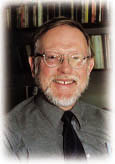 This year Asian-Americans make up about 5 to 6 percent of enrollment,
African-American and Hispanic students each comprise between 2.5 and 3 percent,
and only one or two students are Native Americans, said Associate Dean of
the Graduate School David N. Redman (pictured at right).
This year Asian-Americans make up about 5 to 6 percent of enrollment,
African-American and Hispanic students each comprise between 2.5 and 3 percent,
and only one or two students are Native Americans, said Associate Dean of
the Graduate School David N. Redman (pictured at right).
Princeton also has proposed adding a master's degree in finance, to go
with two other small-scale, professionally oriented master's programs, in
public policy and in engineering, said Redman.
The centennial celebration kicks off at Reunions 2000 and continues for
a year. The Graduate School, established December 13, 1900, is planning
various events, including symposia, a conference on civil society at the
United Nations, a public lecture series, and a gala. In conjunction with
the 100th anniversary, Princeton seeks to raise $100 million for the Graduate
School; to date, the university has brought in $65 million.
-Kathryn Federici Greenwood
The Graduate School's centennial Website is located at www.princeton.edu/centennial.
Students warm to hot fields
Before the Graduate School was founded in 1900, graduate students were
enrolled in a number of programs, including art and archaeology, astronomy,
biology, classics, geology, mathematics, philosophy, and physics. In its
first official year, 1901, the Graduate School boasted 116 students. The
student body and offerings grew steadily through the 1950s. The next decade
saw dramatic expansion-by 1969 enrollment approached 1,500.
Over the past 30 years, enrollment has increased by more than 200, and
research in interdisciplinary and interdepartmental programs such as Materials
Sciences and Engineering has flourished.
Princeton, like many other graduate schools, has slightly downsized its
humanities and social science disciplines in response to the tight job market
in the last five or six years, said Associate Dean of the Graduate School
David N. Redman. Meanwhile, the number of engineering students has grown
in response to the hot fields of electrical engineering and computer science,
as has the number of students in the Woodrow Wilson School and the School
of Architecture.
Graduate School enrollment by discipline:
1969-70 1999-00
Natural sciences 31% 28%
Humanities 25% 20%
Social sciences 19% 15%
Engineering 17% 23%
Woodrow
Wilson School 5% 10%
Architecture 3% 4%
Total enrollment 1,491 1,735
Source: Office of the Dean of the Graduate School
Summer research lures minorities
to Princeton's graduate program
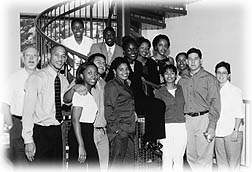 Minorities can get a taste of what it's like to study and conduct research
at a top-notch graduate program through the Graduate School's Princeton
Summer Research Experience. The program seeks to encourage minority undergraduates
from institutions other than Princeton to pursue graduate study, whether
in the humanities, social sciences, natural sciences, or engineering. Twenty-one
students lived on campus last summer, working on projects with individual
faculty advisers. The program had started in 1985, but lapsed after 1996
for two years from lack of money. As part of the Graduate School's effort
to increase minority recruitment, it has infused the program with funds.
Pictured from the left are some of the students who participated in 1999:
(front row) Richard Ellis (Georgia Institute of Technology), Shanaysha Furlow
(University of Maryland), Roberto Razo (California State University, Fullerton),
Ayana Free (Spelman), Tina Enhoffer (Villanova), and Manuel Berrelez (Yale);
(back row) Nandi Leslie (Howard), Jonathan Gillespie (Long Island University),
Stephanie Jones (University of Pennsylvania), Ayesha Hardison (University
of Michigan), and graduate student advisers Michelle Fowles and Stephanie
Smith.
Minorities can get a taste of what it's like to study and conduct research
at a top-notch graduate program through the Graduate School's Princeton
Summer Research Experience. The program seeks to encourage minority undergraduates
from institutions other than Princeton to pursue graduate study, whether
in the humanities, social sciences, natural sciences, or engineering. Twenty-one
students lived on campus last summer, working on projects with individual
faculty advisers. The program had started in 1985, but lapsed after 1996
for two years from lack of money. As part of the Graduate School's effort
to increase minority recruitment, it has infused the program with funds.
Pictured from the left are some of the students who participated in 1999:
(front row) Richard Ellis (Georgia Institute of Technology), Shanaysha Furlow
(University of Maryland), Roberto Razo (California State University, Fullerton),
Ayana Free (Spelman), Tina Enhoffer (Villanova), and Manuel Berrelez (Yale);
(back row) Nandi Leslie (Howard), Jonathan Gillespie (Long Island University),
Stephanie Jones (University of Pennsylvania), Ayesha Hardison (University
of Michigan), and graduate student advisers Michelle Fowles and Stephanie
Smith.
Postdoctoral fellows focus on both
teaching and research
Attracting science and engineering postdoctoral fellows who want to do
research as well as teach is the aim of the Council on Science and Technology's
Postdoctoral Teaching Program. Launched in 1997, the program gives seven
fellows, here for terms of up to three years, the opportunity to conduct
research in the lab of a faculty member and also work with a teaching mentor,
who may or may not be the research mentor.
The university started the program because nationally "there is
a great need to train scientists to be good teachers," said Council
director Shirley M. Tilghman, who is also Howard A. Prior Professor in the
Life Sciences and director of the Institute for Genomic Analysis. "Our
second motivation is very Princeton-centric. We suspect these fellows will
invigorate and enrich our own teaching of science."
Melissa Hughes, a fellow in ecology and evolutionary biology, said, "There
are other so-called teaching postdocs out there, but they require that the
recipient teach two or three courses a semester. That's certainly teaching
experience, but it doesn't leave much time for research." Princeton's
program has allowed her the freedom to experiment in both teaching and research,
she said.
"In many cases," said Matt Trawick, a fellow in physics, "teaching
is actually frowned on professionally. You know: 'Shouldn't you be concentrating
on your research?' This fellowship encourages me to be seriously interested
in teaching and seriously interested in research. I really want to do both,
and to do both well."
What does the future hold for the first crop of fellows? "We hope
they'll be prepared to take up faculty appointments at a variety of educational
institutions, from small liberal arts colleges to research universities,"
said Tilghman. Alex Bradley, the first fellow to finish sometime this year,
is interviewing for faculty positions in chemistry, mainly at liberal arts
schools.
In the meantime, said Bradley, "This program affirms and reaffirms
Princeton's dedication to undergraduate education. It's not just talk, it's
true."
This story is adapted from one by Caroline Moseley that appeared in the
Princeton Weekly Bulletin.
Nassau Hall 2000 . . . cocoa cups
. . . oboe wish
 When it came to ushering in the new millennium, Prince- ton's front
campus could not compete with the Eiffel Tower's splendid display of orgasmic
fire, nor with London's eye-popping pyrotechnics. But for those 1,500 people
who waited in front of Nassau Hall for the year 2000, it was sweetly satisfying
to count down with President Shapiro and along with revelers in New York's
Times Square, as seen from a giant television screen. At midnight, Kenny
Grayson, foreman of the university's electrical and elevator shops, led
the crowd in "Auld Lang Syne," followed by "The Battle Hymn
of the Republic." The public-address system then boomed Buster Poindexter's
mid-1980s' hit "Hot, Hot, Hot," and conga lines wound through
the crowd. Some revelers, sporting black tie and ball gowns, drank champagne;
others, bundled in parkas and watch caps, waved illuminated wands. One nine-year-old,
with glow-in-the-dark, 2000-glasses perched on her nose, threw fistfuls
of confetti into the air. All too soon, the music ended, the television
screen went dark, and the crowd dissipated into the damp night.
When it came to ushering in the new millennium, Prince- ton's front
campus could not compete with the Eiffel Tower's splendid display of orgasmic
fire, nor with London's eye-popping pyrotechnics. But for those 1,500 people
who waited in front of Nassau Hall for the year 2000, it was sweetly satisfying
to count down with President Shapiro and along with revelers in New York's
Times Square, as seen from a giant television screen. At midnight, Kenny
Grayson, foreman of the university's electrical and elevator shops, led
the crowd in "Auld Lang Syne," followed by "The Battle Hymn
of the Republic." The public-address system then boomed Buster Poindexter's
mid-1980s' hit "Hot, Hot, Hot," and conga lines wound through
the crowd. Some revelers, sporting black tie and ball gowns, drank champagne;
others, bundled in parkas and watch caps, waved illuminated wands. One nine-year-old,
with glow-in-the-dark, 2000-glasses perched on her nose, threw fistfuls
of confetti into the air. All too soon, the music ended, the television
screen went dark, and the crowd dissipated into the damp night.
To avoid possible Y2K problems, the university took the precaution of
closing all offices from December 30 through January 1. A core staff of
administrators and computer specialists were at the ready to usher in the
New Year and to avert any electronic disasters. Not to worry; by 1 a.m.,
it was apparent that no major glitches had occurred. A special 1-800 hot
line reported an all-clear to callers, but for cybersurfers trying to find
an all-clear message on the university's Website, it was impossible-the
university had taken its computer systems temporarily off-line. By 6 a.m.,
though, the Website was accessible, and the university was back to business
as usual.
In a deliberate act of goodwill, Todd Johnson '03 and Danny Fahim '01
last month inaugurated a new club, Random Acts of Kindness, by giving out
cups of hot chocolate to passersby in front of the chapel. Future gestures
are yet to be decided upon, but might possibly include lemonade come spring.
Joseph Robinson *66, principal oboist for the New York Philharmonic,
in a concert at Lincoln Center on December 11, took pride in the 16-year-old
who sat next to him. Johanna Johnson, who had been diagnosed the previous
year with Hodgkin's disease, told the Make A Wish Foundation that she wanted
"to sit in the middle of a fine orchestra." Johnson, who has played
clarinet for five years and oboe for two, was given her wish; not only did
she play with Robinson, but before the concert, he gave her personal instruction
and a new, top-of-the-line oboe. Johnson, whose cancer appears to be in
remission, said in The New York Times, "My wish came true."
GO TO
the Table of Contents of the current issue
GO TO
PAW's home page
PAW@princeton.edu
 On October 15, Princeton psychologist Elizabeth Gould and her collaborators,
including Professor of Psychology Charles G. Gross, reported that in primates
the most advanced area of the adult brain receives fresh supplies of neurons
daily. The neuron is the basic unit in the brain's operating system, and
the discovery was a milestone in neuroscience. It delivered a final blow
to the longstanding belief that the adult brain can only lose neurons, never
add them. That dogma had begun to crumble in recent years, partly because
of earlier work by Gould showing that neurogenesis, the birth of neurons,takes
place in a more primitive part of the brain.
On October 15, Princeton psychologist Elizabeth Gould and her collaborators,
including Professor of Psychology Charles G. Gross, reported that in primates
the most advanced area of the adult brain receives fresh supplies of neurons
daily. The neuron is the basic unit in the brain's operating system, and
the discovery was a milestone in neuroscience. It delivered a final blow
to the longstanding belief that the adult brain can only lose neurons, never
add them. That dogma had begun to crumble in recent years, partly because
of earlier work by Gould showing that neurogenesis, the birth of neurons,takes
place in a more primitive part of the brain. The Anniversary Campaign reached its revised goal of $900 million in
early November, eight months ahead of schedule. But Vice-President for Development
Van Zandt Williams, Jr. '65 cautions that the work is far from over. Some
categories of the campaign, such as academic programs, have been more successful
than others, leaving four areas in particular underfunded: Annual Giving,
financial aid, the Presidential Teaching Initiatives, and new buildings.
The Anniversary Campaign reached its revised goal of $900 million in
early November, eight months ahead of schedule. But Vice-President for Development
Van Zandt Williams, Jr. '65 cautions that the work is far from over. Some
categories of the campaign, such as academic programs, have been more successful
than others, leaving four areas in particular underfunded: Annual Giving,
financial aid, the Presidential Teaching Initiatives, and new buildings. When Colum P. Hourihane arrived from London's Courtauld Institute to
take charge of Princeton's Index of Christian Art in 1997, staff members
worked on just one computer-what the Irish-born Hourihane calls "a
data-entry machine." Barely 1 percent of the Index's 250,000 text entries,
which describe the works of art, were on the Internet, and none of the 150,000
photographs had been digitized. Today 18,000 text entries are online and
15,000 photographs have been digitized.
When Colum P. Hourihane arrived from London's Courtauld Institute to
take charge of Princeton's Index of Christian Art in 1997, staff members
worked on just one computer-what the Irish-born Hourihane calls "a
data-entry machine." Barely 1 percent of the Index's 250,000 text entries,
which describe the works of art, were on the Internet, and none of the 150,000
photographs had been digitized. Today 18,000 text entries are online and
15,000 photographs have been digitized. Datus C. Smith, Jr. '29, a book publisher and a former editor of the
Princeton Alumni Weekly died November 17. He was 92. After editing PAW from
1931 to 1939, he was the director of the Princeton University Press until
1952. Smith then served as president of Franklin Book Programs, a nonprofit
organization promoting the development of book publishing in the Third World.
Datus C. Smith, Jr. '29, a book publisher and a former editor of the
Princeton Alumni Weekly died November 17. He was 92. After editing PAW from
1931 to 1939, he was the director of the Princeton University Press until
1952. Smith then served as president of Franklin Book Programs, a nonprofit
organization promoting the development of book publishing in the Third World. This year Asian-Americans make up about 5 to 6 percent of enrollment,
African-American and Hispanic students each comprise between 2.5 and 3 percent,
and only one or two students are Native Americans, said Associate Dean of
the Graduate School David N. Redman (pictured at right).
This year Asian-Americans make up about 5 to 6 percent of enrollment,
African-American and Hispanic students each comprise between 2.5 and 3 percent,
and only one or two students are Native Americans, said Associate Dean of
the Graduate School David N. Redman (pictured at right). Minorities can get a taste of what it's like to study and conduct research
at a top-notch graduate program through the Graduate School's Princeton
Summer Research Experience. The program seeks to encourage minority undergraduates
from institutions other than Princeton to pursue graduate study, whether
in the humanities, social sciences, natural sciences, or engineering. Twenty-one
students lived on campus last summer, working on projects with individual
faculty advisers. The program had started in 1985, but lapsed after 1996
for two years from lack of money. As part of the Graduate School's effort
to increase minority recruitment, it has infused the program with funds.
Pictured from the left are some of the students who participated in 1999:
(front row) Richard Ellis (Georgia Institute of Technology), Shanaysha Furlow
(University of Maryland), Roberto Razo (California State University, Fullerton),
Ayana Free (Spelman), Tina Enhoffer (Villanova), and Manuel Berrelez (Yale);
(back row) Nandi Leslie (Howard), Jonathan Gillespie (Long Island University),
Stephanie Jones (University of Pennsylvania), Ayesha Hardison (University
of Michigan), and graduate student advisers Michelle Fowles and Stephanie
Smith.
Minorities can get a taste of what it's like to study and conduct research
at a top-notch graduate program through the Graduate School's Princeton
Summer Research Experience. The program seeks to encourage minority undergraduates
from institutions other than Princeton to pursue graduate study, whether
in the humanities, social sciences, natural sciences, or engineering. Twenty-one
students lived on campus last summer, working on projects with individual
faculty advisers. The program had started in 1985, but lapsed after 1996
for two years from lack of money. As part of the Graduate School's effort
to increase minority recruitment, it has infused the program with funds.
Pictured from the left are some of the students who participated in 1999:
(front row) Richard Ellis (Georgia Institute of Technology), Shanaysha Furlow
(University of Maryland), Roberto Razo (California State University, Fullerton),
Ayana Free (Spelman), Tina Enhoffer (Villanova), and Manuel Berrelez (Yale);
(back row) Nandi Leslie (Howard), Jonathan Gillespie (Long Island University),
Stephanie Jones (University of Pennsylvania), Ayesha Hardison (University
of Michigan), and graduate student advisers Michelle Fowles and Stephanie
Smith. When it came to ushering in the new millennium, Prince- ton's front
campus could not compete with the Eiffel Tower's splendid display of orgasmic
fire, nor with London's eye-popping pyrotechnics. But for those 1,500 people
who waited in front of Nassau Hall for the year 2000, it was sweetly satisfying
to count down with President Shapiro and along with revelers in New York's
Times Square, as seen from a giant television screen. At midnight, Kenny
Grayson, foreman of the university's electrical and elevator shops, led
the crowd in "Auld Lang Syne," followed by "The Battle Hymn
of the Republic." The public-address system then boomed Buster Poindexter's
mid-1980s' hit "Hot, Hot, Hot," and conga lines wound through
the crowd. Some revelers, sporting black tie and ball gowns, drank champagne;
others, bundled in parkas and watch caps, waved illuminated wands. One nine-year-old,
with glow-in-the-dark, 2000-glasses perched on her nose, threw fistfuls
of confetti into the air. All too soon, the music ended, the television
screen went dark, and the crowd dissipated into the damp night.
When it came to ushering in the new millennium, Prince- ton's front
campus could not compete with the Eiffel Tower's splendid display of orgasmic
fire, nor with London's eye-popping pyrotechnics. But for those 1,500 people
who waited in front of Nassau Hall for the year 2000, it was sweetly satisfying
to count down with President Shapiro and along with revelers in New York's
Times Square, as seen from a giant television screen. At midnight, Kenny
Grayson, foreman of the university's electrical and elevator shops, led
the crowd in "Auld Lang Syne," followed by "The Battle Hymn
of the Republic." The public-address system then boomed Buster Poindexter's
mid-1980s' hit "Hot, Hot, Hot," and conga lines wound through
the crowd. Some revelers, sporting black tie and ball gowns, drank champagne;
others, bundled in parkas and watch caps, waved illuminated wands. One nine-year-old,
with glow-in-the-dark, 2000-glasses perched on her nose, threw fistfuls
of confetti into the air. All too soon, the music ended, the television
screen went dark, and the crowd dissipated into the damp night.